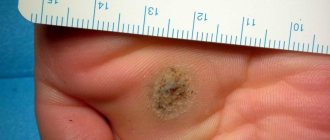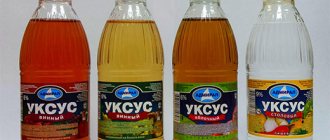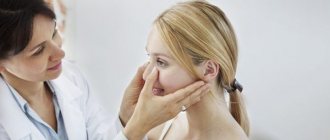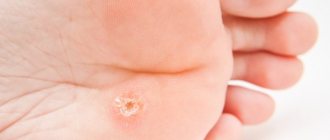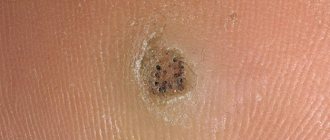A tumor on the foot can cause a lot of trouble to its owner - it causes discomfort, itching, pain while walking and wearing tight shoes. With strong mechanical stress, it may begin to bleed. Well, the growth on the foot doesn’t look very attractive. It can cause you to refuse to wear open shoes and walk barefoot. Therefore, it is quite natural that every owner of such a defect wants to get rid of it. But doing this with folk remedies at home is highly not recommended, because depending on the type and nature of the formation, different treatment regimens are provided. The difference between a wart and a callus lies in the reasons that caused the defect to appear, in the periods of development, and in the structure of the formation itself. Let's talk about this in more detail.
What is the difference between a callus and a corn?
In dermatology, the description of dry callus comes down to the appearance of a new growth on the skin due to skin friction. For example, uncomfortable shoes can damage the skin. Over time, the skin at the site of exposure becomes rough. The growth in the form of a flesh-colored or yellow tubercle becomes hard. When pressing on the callus, the patient may experience slight pain, although it does not have nerve endings or blood vessels. The reason is the effect on surrounding tissues.
Warts are the result of the human papillomavirus. You can become infected through towels and common hygiene items. The virus penetrates through microcracks in the skin. It can sleep for a long time, but under the influence of certain factors (hypothermia, infection, weakened immunity) it is activated and causes improper division of epidermal cells. Plantar warts resemble a callus. These are the same flesh-colored bumps, so they are often confused with a callus. But they are riddled with blood vessels, often bleed, and cause pain when walking.
So, the difference between a callus and a wart is in the causes and nature of its formation. The treatment is also different.
How to distinguish a plantar wart from a callus of the sole?
In the presence of a callus, the skin pattern is preserved, there are no “black spots”, pain occurs with perpendicular pressure on the lesion, and not with lateral pressure. In doubtful cases, the doctor can use dermatoscopy - a method of visualizing skin structures under 10-20 times magnification using a dermatoscope apparatus.
Warts have a characteristic dermoscopic picture and differ from the picture of a core callus.
Predisposing factors for the occurrence of plantar warts:
- hyperhidrosis of the feet - increased humidity;
- long-term wearing of rubber and sports shoes;
- narrow and high-heeled shoes;
- deformation of the foot and fingers due to flat feet, arthritis, arthrosis.
How to treat a callus and how to remove a wart?
Since a callus is simply hardened skin, it is enough to soften it and carefully remove it mechanically. It is better to do this in a dermatologist's office so as not to damage the surrounding tissue. You cannot do this with a wart, because it is a formation of a viral nature permeated with capillaries. Unprofessional intervention can lead to rapid growth and even greater discomfort when walking.
To remove warts, it is recommended to use a laser, which vaporizes the pathological tissue completely, without leaving cells generated by HPV. The advantage of the method is its bloodlessness and the possibility of targeted impact. Relapses are rare. And this is another big plus of laser wart removal technology.
A callus, like a wart, can also be removed with a laser. But it is not recommended to remove the wart mechanically, as bleeding and reappearance of the formation are possible. This is the difference between a callus and a corn.
Wart - symptoms and treatment
When to see a doctor
Patients with warts often turn to the doctor to eliminate an aesthetic defect.
Some types of warts cause pain when walking or crack, in which case it is better to remove them. There are several ways to treat warts. All of them are usually carried out under the supervision of a doctor, and some of them are carried out only in the clinic’s treatment room.
Chemical treatments
To get rid of warts, applications of milk-salicylic collodion and salicylic patches are used. The percentage of drugs and the method of their use (long-term wearing of patches, applications, etc.) depend on the prevalence and localization of the tumor.
Solutions of zinc and 2-chloropropionic acid can also be used. In this case, a chemical composition is applied to the pre-treated surface, which is left on the wart until the color changes (depending on the type of wart). The procedure is repeated several times after 7, 14 and 21 days. Before each procedure, tissue is removed mechanically.
Another chemical method is a combination of nitric, acetic, oxalic, lactic acids and copper nitrate trihydrate. Only relatively small tumors - up to 5 mm - are treated in this way. The solution is also left until the wart changes color. After 3-5 days, the patient comes for a follow-up appointment; if necessary, he is prescribed a repeat procedure after 1-4 weeks [5].
Cryodestruction
This method involves freezing the wart using liquid nitrogen: a moistened swab is pressed against the damaged skin (covering several mm of surrounding tissue) for 1-5 minutes. The destruction of some tumors requires several procedures with an interval of four weeks.
The main disadvantages of cryodestruction are its pain and delayed effect compared to other methods, in which only one procedure is often sufficient for removal.
Electrocoagulation
Under the influence of electric current, the wart is removed in layers. This operation is performed under local anesthetic [6].
This method is more effective than cryodestruction, but it has a significant disadvantage: electrocoagulation often leaves behind scars at the site of wart removal. For those patients who come to eliminate a cosmetic defect, this method will not be the most suitable.
Laser destruction
Warts are also removed in layers using a laser. The light guide contacts the skin from several seconds to three minutes, depending on the size. Then the resulting scab is excised, and the bottom of the wound is treated with a laser again. The patient is then instructed on how to treat the wound. The operation itself is performed under local anesthesia.
Radio wave surgery
Radio wave surgery is one of the most modern and gentle methods for removing some benign tumors, including warts. For this treatment, the devices Surgitron (USA), PBX oscillator (Russia), Vesalius (Italy), etc. are used.
The method is based on the generation of electromagnetic waves with different frequencies: from 100 kHz to 105 MHz [7]. When the wave passes through the tissue, During the procedure, the tissue resists the passing waves, causing molecular energy to be released in the cells, which heats the skin. When exposed to heat, the cells actually evaporate, creating a neat cut. In this case, no mechanical forces are applied to the affected tissue.
The advantages of this method:
- safety;
- rapid wound healing;
- good cosmetic effect - scars and cicatrices are excluded;
- relative painlessness - a local anesthetic is used before the mini-operation;
- exclusion of secondary infection due to automatic disinfection of the electrode when the device is turned on.
The effectiveness of this method is recognized all over the world, but it is quite difficult to find a clinic that uses the method of radio wave surgery.
Preparations for the treatment of warts
There are no antiviral drugs for the treatment of HPV yet, so it is impossible to get rid of warts with the help of pills. They can only be removed by chemical and physical methods.
Which treatment method to choose
All of the above methods have several disadvantages:
- In the first couple of weeks, the operated area has an unattractive appearance - crusts, darkening of the tissues. This must be taken into account if the warts are on visible parts of the body (for example, on the face).
- Unpleasant odor and some degree of pain during surgery.
In addition, each of these methods has contraindications, which you should learn about at a preliminary consultation with a dermatologist.
But the main disadvantage is the high probability of relapses, especially if the warts were widespread and extensive. With each of these methods, doctors fight not the root cause of the disease, but its consequences, since today the human papillomavirus cannot be cured.
Therefore, therapy is aimed at:
- or to destroy tumors that arise at the site of virus introduction;
- or to stimulate an antiviral immune response;
- or a combination of these approaches [8].
Most often, destructive methods of treatment are used. Their efficiency reaches 50-80% [4].
For surgical treatment methods, childhood is usually not a contraindication. Therefore, many of these methods (including radio wave surgery) are also used to treat warts in children. An exception is the chemical removal of warts due to the possibility of adverse reactions to the substance.
What to do after surgery
After any of these surgeries, be sure to follow your doctor's recommendations.
After removing a tumor using any of the presented methods, the doctor usually prescribes treatment of the removal site. It is forbidden to remove the “crusts” yourself, wet the wound or expose it to direct sunlight.
If a patient constantly develops new warts, then he should consult an immunologist - he may need to take medications that will increase the body's resistance to the human papillomavirus.
Myths and dangerous misconceptions in the treatment of warts
Warts are usually harmless and often disappear on their own over time. This property explains numerous myths about healing using spells and other unconventional methods.
Treatment of warts with home remedies is unacceptable, since the patient will not be able to accurately distinguish a wart from other diseases without the necessary equipment, and complications after such “treatment” occur much more often than recovery.
Only a doctor can select a treatment method after examination and an accurate diagnosis.
Constant pressure as the main reason
The painful yellow callus has a scientific name - clavus. This formation is up to 12 cm in size, created by the accumulation of dead skin that rubs against shoes. Calluses traditionally appear in areas subject to pressure. Therefore, they are most often found on the knuckles, big toes and heels due to unsuitable shoes. In people with orthopedic foot defects, they can occur in other places, but most often on the feet, around or between the toes.
When constantly wearing unsuitable shoes, the skin begins to become horny and thicken, forming a formation with a rough surface. If you scratch it with your fingernail, it will begin to crumble and turn slightly white.
Most often, in women, calluses occur as a result of wearing pumps, in men - low shoes.
This problem mainly affects women who prefer high heels - for them the reason is frequent intense friction between the shoes and the surface of the foot. As a result, a callus appears on the foot. What does this problem mean?
If you have suffered from calluses all your life, then barefoot shoes are the best solution. These are shoes that imitate barefoot walking thanks to a thin flexible sole. It provides freedom to the toes and is almost not felt on the feet. Through the thin sole, the foot feels the surface on which it steps. Thanks to this, the feet work naturally, but at the same time are protected from possible injuries.
How do plantar warts appear?
HPV infection with entry and penetration into the skin of the soles occurs through microtraumas and abrasions, small abrasions when walking barefoot on sand, earth, in bathhouses, swimming pools, fitness clubs, as well as when using other people's slippers, flip-flops, foot towels, bed linen. A direct route of transmission of the virus is also possible - through direct contact with the skin of a patient.
About a third of cases of plantar warts are capable of self-resolution within 100–120 days or more, but during this time there is a potential danger of infection of family members, discomfort and pain when walking, and the appearance of multiple plantar warts. Therefore, treatment is necessary to improve the patient's quality of life and reduce the risk of infection to others.
The main treatment for plantar warts is removal. In some cases (with multiple difficult-to-treat warts, the presence of immunodeficiency), a specialist may suggest immunotropic therapy in the form of injectable drugs or tablets that help the body fight HPV. Removal of warts in such cases is performed as part of general treatment.
What prevention methods are recommended for patients with plantar warts?
To prevent the appearance of plantar warts, patients are recommended to:
- Maintain foot skin hygiene. To do this, you need to wash your feet daily with soap, use individual towels and washcloths, shoes, change socks daily, wash and change foot towels in a timely manner.
- Visit public places (baths, saunas, swimming pools, fitness clubs) in appropriate shoes.
- Have individual pedicure tools.
- Select comfortable shoes, use sports and rubber shoes only for their intended purpose.
To prevent the appearance of plantar warts, in case of trauma, it is necessary to promptly treat these areas of the skin of the soles with antiseptics: a solution of chlorhexidine, alcohol, hydrogen peroxide, promptly treat cracks on the soles and eliminate hyperhidrosis of the feet.
Complex "Scholl"
There are many home treatment options for calluses. These are either products that remove dead and hardened skin, or substances that relieve pain and soften keratinization.
Thanks to the Scholl complex, you can use these methods separately or simultaneously.
Suitable treatment is provided by Scholl Express 2-in-1. The package contains a double-action nail file + urea-based liquid, relieves pain and removes calluses.
First, apply the liquid to the corns to soften the hard skin, then use a file to carefully remove the horny areas. The liquid contains salicylic acid, which perfectly softens and moisturizes the skin.
The Scholl complex is suitable for eliminating not only core calluses. It helps to cope with other types of skin formations, soften and smooth the heels.
“Scholl” gel pads will reduce pressure on the foot when walking and, with regular use, will provide pain relief. To soften keratinization around the toes, you can use Scholl foot cream. It moisturizes and softens the skin.
Treatment at home and folk advice
There are many tips on how to get rid of calluses. But the use of herbs and other types of natural therapy does not provide an instant effect - the result is visible only with regular, patient use.
Yarrow allows you to combine the treatment of corns with evening relaxation and a pleasant foot bath. Pour a handful of yarrow into 3 liters of boiling water, add 1 tsp. salt, cover the container with a lid and leave to brew. When the broth becomes pleasantly warm, strain it and soak your feet in it for about 20 minutes. Take a bath every day.
Acute sedum will help soften rough skin, which is the basis of the core callus. Mash its fresh leaves and apply them to the affected area. Such treatment can only be carried out during the flowering period of the plant - in July. Be very careful when handling sedum - it is a poisonous plant and should not be used internally. Also beware of contact with eyes.
Celandine has also proven itself excellent in the treatment of calluses. Rub the seal with plant sap. Carry out the procedure daily.
Other folk methods
If you decide to get rid of the skin tag yourself, try some of the following tips.
- Soak your foot in warm water or apply salicylic acid until the skin on the horny area turns white. Carefully remove and apply a patch to the treated area. After 4 days, remove the patch. Repeat the procedure until healing.
- A patch soaked in salicylic acid purchased at a pharmacy can also become a reliable assistant. Make sure that the patch has not moved - the active substance is only present in certain areas of it.
- Soak a slice of onion in vinegar for several hours, and in the evening stick it to the calluses. In the morning, wash your feet in warm water. Repeat the procedure until the core of the callus is removed.
- Try massaging the keratinized area. Gently kneading can help remove the core of the corn.
- Rub a jasmine flower, apply it to the calluses, and secure with a band-aid. Replace the compress after 5 days. Repeat the procedure until healing (about 3-5 times).
- A commonly used agent is formic acid. Buy it at the pharmacy and use it according to the instructions.
- You can use lemon juice and a clove of garlic to lubricate the affected area.
Home treatment methods are best combined with pharmacotherapy. Natural substances themselves most often do not cope with the task effectively enough.
